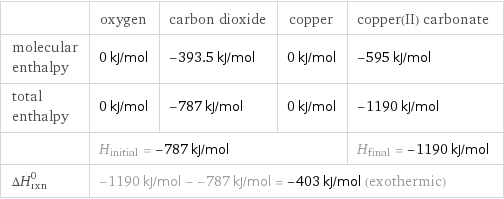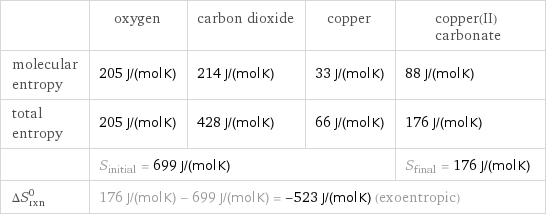Input interpretation

O_2 oxygen + CO_2 carbon dioxide + Cu copper ⟶ CuCO_3 copper(II) carbonate
Balanced equation

Balance the chemical equation algebraically: O_2 + CO_2 + Cu ⟶ CuCO_3 Add stoichiometric coefficients, c_i, to the reactants and products: c_1 O_2 + c_2 CO_2 + c_3 Cu ⟶ c_4 CuCO_3 Set the number of atoms in the reactants equal to the number of atoms in the products for O, C and Cu: O: | 2 c_1 + 2 c_2 = 3 c_4 C: | c_2 = c_4 Cu: | c_3 = c_4 Since the coefficients are relative quantities and underdetermined, choose a coefficient to set arbitrarily. To keep the coefficients small, the arbitrary value is ordinarily one. For instance, set c_1 = 1 and solve the system of equations for the remaining coefficients: c_1 = 1 c_2 = 2 c_3 = 2 c_4 = 2 Substitute the coefficients into the chemical reaction to obtain the balanced equation: Answer: | | O_2 + 2 CO_2 + 2 Cu ⟶ 2 CuCO_3
Structures

+ + ⟶
Names

oxygen + carbon dioxide + copper ⟶ copper(II) carbonate
Reaction thermodynamics
Enthalpy

| oxygen | carbon dioxide | copper | copper(II) carbonate molecular enthalpy | 0 kJ/mol | -393.5 kJ/mol | 0 kJ/mol | -595 kJ/mol total enthalpy | 0 kJ/mol | -787 kJ/mol | 0 kJ/mol | -1190 kJ/mol | H_initial = -787 kJ/mol | | | H_final = -1190 kJ/mol ΔH_rxn^0 | -1190 kJ/mol - -787 kJ/mol = -403 kJ/mol (exothermic) | | |
Entropy

| oxygen | carbon dioxide | copper | copper(II) carbonate molecular entropy | 205 J/(mol K) | 214 J/(mol K) | 33 J/(mol K) | 88 J/(mol K) total entropy | 205 J/(mol K) | 428 J/(mol K) | 66 J/(mol K) | 176 J/(mol K) | S_initial = 699 J/(mol K) | | | S_final = 176 J/(mol K) ΔS_rxn^0 | 176 J/(mol K) - 699 J/(mol K) = -523 J/(mol K) (exoentropic) | | |
Equilibrium constant
![Construct the equilibrium constant, K, expression for: O_2 + CO_2 + Cu ⟶ CuCO_3 Plan: • Balance the chemical equation. • Determine the stoichiometric numbers. • Assemble the activity expression for each chemical species. • Use the activity expressions to build the equilibrium constant expression. Write the balanced chemical equation: O_2 + 2 CO_2 + 2 Cu ⟶ 2 CuCO_3 Assign stoichiometric numbers, ν_i, using the stoichiometric coefficients, c_i, from the balanced chemical equation in the following manner: ν_i = -c_i for reactants and ν_i = c_i for products: chemical species | c_i | ν_i O_2 | 1 | -1 CO_2 | 2 | -2 Cu | 2 | -2 CuCO_3 | 2 | 2 Assemble the activity expressions accounting for the state of matter and ν_i: chemical species | c_i | ν_i | activity expression O_2 | 1 | -1 | ([O2])^(-1) CO_2 | 2 | -2 | ([CO2])^(-2) Cu | 2 | -2 | ([Cu])^(-2) CuCO_3 | 2 | 2 | ([CuCO3])^2 The equilibrium constant symbol in the concentration basis is: K_c Mulitply the activity expressions to arrive at the K_c expression: Answer: | | K_c = ([O2])^(-1) ([CO2])^(-2) ([Cu])^(-2) ([CuCO3])^2 = ([CuCO3])^2/([O2] ([CO2])^2 ([Cu])^2)](../image_source/6856f6140e9a852d31010583f2e19167.png)
Construct the equilibrium constant, K, expression for: O_2 + CO_2 + Cu ⟶ CuCO_3 Plan: • Balance the chemical equation. • Determine the stoichiometric numbers. • Assemble the activity expression for each chemical species. • Use the activity expressions to build the equilibrium constant expression. Write the balanced chemical equation: O_2 + 2 CO_2 + 2 Cu ⟶ 2 CuCO_3 Assign stoichiometric numbers, ν_i, using the stoichiometric coefficients, c_i, from the balanced chemical equation in the following manner: ν_i = -c_i for reactants and ν_i = c_i for products: chemical species | c_i | ν_i O_2 | 1 | -1 CO_2 | 2 | -2 Cu | 2 | -2 CuCO_3 | 2 | 2 Assemble the activity expressions accounting for the state of matter and ν_i: chemical species | c_i | ν_i | activity expression O_2 | 1 | -1 | ([O2])^(-1) CO_2 | 2 | -2 | ([CO2])^(-2) Cu | 2 | -2 | ([Cu])^(-2) CuCO_3 | 2 | 2 | ([CuCO3])^2 The equilibrium constant symbol in the concentration basis is: K_c Mulitply the activity expressions to arrive at the K_c expression: Answer: | | K_c = ([O2])^(-1) ([CO2])^(-2) ([Cu])^(-2) ([CuCO3])^2 = ([CuCO3])^2/([O2] ([CO2])^2 ([Cu])^2)
Rate of reaction
![Construct the rate of reaction expression for: O_2 + CO_2 + Cu ⟶ CuCO_3 Plan: • Balance the chemical equation. • Determine the stoichiometric numbers. • Assemble the rate term for each chemical species. • Write the rate of reaction expression. Write the balanced chemical equation: O_2 + 2 CO_2 + 2 Cu ⟶ 2 CuCO_3 Assign stoichiometric numbers, ν_i, using the stoichiometric coefficients, c_i, from the balanced chemical equation in the following manner: ν_i = -c_i for reactants and ν_i = c_i for products: chemical species | c_i | ν_i O_2 | 1 | -1 CO_2 | 2 | -2 Cu | 2 | -2 CuCO_3 | 2 | 2 The rate term for each chemical species, B_i, is 1/ν_i(Δ[B_i])/(Δt) where [B_i] is the amount concentration and t is time: chemical species | c_i | ν_i | rate term O_2 | 1 | -1 | -(Δ[O2])/(Δt) CO_2 | 2 | -2 | -1/2 (Δ[CO2])/(Δt) Cu | 2 | -2 | -1/2 (Δ[Cu])/(Δt) CuCO_3 | 2 | 2 | 1/2 (Δ[CuCO3])/(Δt) (for infinitesimal rate of change, replace Δ with d) Set the rate terms equal to each other to arrive at the rate expression: Answer: | | rate = -(Δ[O2])/(Δt) = -1/2 (Δ[CO2])/(Δt) = -1/2 (Δ[Cu])/(Δt) = 1/2 (Δ[CuCO3])/(Δt) (assuming constant volume and no accumulation of intermediates or side products)](../image_source/8330df20a7886d7c1d601653492e07c8.png)
Construct the rate of reaction expression for: O_2 + CO_2 + Cu ⟶ CuCO_3 Plan: • Balance the chemical equation. • Determine the stoichiometric numbers. • Assemble the rate term for each chemical species. • Write the rate of reaction expression. Write the balanced chemical equation: O_2 + 2 CO_2 + 2 Cu ⟶ 2 CuCO_3 Assign stoichiometric numbers, ν_i, using the stoichiometric coefficients, c_i, from the balanced chemical equation in the following manner: ν_i = -c_i for reactants and ν_i = c_i for products: chemical species | c_i | ν_i O_2 | 1 | -1 CO_2 | 2 | -2 Cu | 2 | -2 CuCO_3 | 2 | 2 The rate term for each chemical species, B_i, is 1/ν_i(Δ[B_i])/(Δt) where [B_i] is the amount concentration and t is time: chemical species | c_i | ν_i | rate term O_2 | 1 | -1 | -(Δ[O2])/(Δt) CO_2 | 2 | -2 | -1/2 (Δ[CO2])/(Δt) Cu | 2 | -2 | -1/2 (Δ[Cu])/(Δt) CuCO_3 | 2 | 2 | 1/2 (Δ[CuCO3])/(Δt) (for infinitesimal rate of change, replace Δ with d) Set the rate terms equal to each other to arrive at the rate expression: Answer: | | rate = -(Δ[O2])/(Δt) = -1/2 (Δ[CO2])/(Δt) = -1/2 (Δ[Cu])/(Δt) = 1/2 (Δ[CuCO3])/(Δt) (assuming constant volume and no accumulation of intermediates or side products)
Chemical names and formulas

| oxygen | carbon dioxide | copper | copper(II) carbonate formula | O_2 | CO_2 | Cu | CuCO_3 Hill formula | O_2 | CO_2 | Cu | CCuO_3 name | oxygen | carbon dioxide | copper | copper(II) carbonate IUPAC name | molecular oxygen | carbon dioxide | copper | copper carbonate
Substance properties

| oxygen | carbon dioxide | copper | copper(II) carbonate molar mass | 31.998 g/mol | 44.009 g/mol | 63.546 g/mol | 123.55 g/mol phase | gas (at STP) | gas (at STP) | solid (at STP) | solid (at STP) melting point | -218 °C | -56.56 °C (at triple point) | 1083 °C | 200 °C boiling point | -183 °C | -78.5 °C (at sublimation point) | 2567 °C | density | 0.001429 g/cm^3 (at 0 °C) | 0.00184212 g/cm^3 (at 20 °C) | 8.96 g/cm^3 | solubility in water | | | insoluble | surface tension | 0.01347 N/m | | | dynamic viscosity | 2.055×10^-5 Pa s (at 25 °C) | 1.491×10^-5 Pa s (at 25 °C) | | odor | odorless | odorless | odorless |
Units
